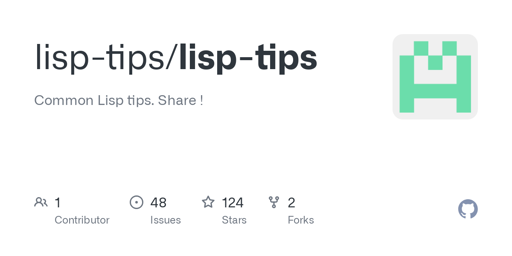Paolo Amoroso
Astronomy, space, Android & Google, retrocomputing, Lisp, Python, coding.
- blog (Fediverse:
@paolo@journal.paoloamoroso.com) - personal site
- GitHub
@amoroso@fosstodon.org
- 20 Posts
- 12 Comments
Because it’s the most effective and powerful tool for putting the Unix philosophy into practice.

 1·1 year ago
1·1 year agoVokoscreenNG is a screencasting tool that works with Raspberry Pi OS, I tested it on my Pi 400. And it’s also easy to install, just
sudo apt install vokoscreen-ng gstreamer1.0-pipewire.I’ve updated the post.

 4·1 year ago
4·1 year agoLooks nice indeed, thanks.

 41·1 year ago
41·1 year agoInteresting suggestion but possibly overkill.

 2·2 years ago
2·2 years agoWhich dialect of Lisp do you use?
Currently Interlisp and Common Lisp, mostly under Medley.
What problems do you solve?
I use Lisp for my hobby programming, not necessarily for solving practical problems. I enjoy coding for the intellectual pleasure of creating, exploring algorithms and systems, and learning computing.
Why do you choose Lisp to solve these problems?
I have been checking out several programming languages for the past four decades or so and Lisp is the only family of languages that doesn’t just come the most natural to me, it gives me pure joy.
Zutty, the Zero-cost Unicode Teletype which the developer describes as “A high-end terminal for low-end systems”.

 1·2 years ago
1·2 years ago- Which Lisp do you most often program in?
These days I use mostly Interlisp and Common Lisp under Medley, the restored and revived Interlisp-D environment of the Xerox Lisp Machines developed at Xerox PARC since the early 1980s.
- What does your Lisp development environment or IDE look like?
Here you can see some screenshots of my Medley environment. It comprises all the traditional Interlisp development tools such as the SEdit structure editor, the File Manager, and Masterscope.
- How did you get started with Lisp? Did you follow any particular articles to set up your environment or begin learning Lisp?
In the early 1990s I took an introductory computer science class based on SICP and fell in love with Scheme. I later learned Common Lisp and Emacs Lisp, and I’ve been programming almost exclusively in Lisp on and off since then.

 1·2 years ago
1·2 years agoGlad you liked the paper, I found this angle interesting too.

 1·2 years ago
1·2 years agoI initially got a Z80-MBC2, a Z80-based SBC that runs CP/M and other operating systems, as I had developed an Intel 8080 cross assembler and wanted to run on actual hardware the code assembled with it. It was so fun I got a V20-MBC, an SBC by the same maker that features a Nec V20 (8088 + 8080) and can run CP/M-86.
Both SBCs led me down a fascinating retrocomputing rabbit hole.

 1·2 years ago
1·2 years agoGood catch, thanks.
Can you share the book’s title and authors?



1. What Lisp programming languages do you use?
I use pretty much only languages in the Lisp family. Since I’m a hobby programmer I’m the boss and get to decide what tools to use.
2. What non-Lisp programming languages do you use?
None, at least regularly.
3. What is your favorite Lisp programming language? Why?
Interlisp and Common Lisp because my daily driver is the wonderful Medley Interlisp development environment, which supports both dialects.
4. What is your favorite non-Lisp programming language? Why?
AWK. I love its combination of simplicity, abstraction, control paradigm, and support for rapid development.
5. What is that one thing about your favorite non-Lisp language that you wish to see in your favorite Lisp language?
I wouldn’t necessarily want to see AWK or some of its features in Lisp. Some of these features are already in Lisp and, as for the others, I don’t mind dusting off AWK itself when needed.